Copper cookware has been the gold standard in professional kitchens for centuries, prized for its exceptional heat conductivity and precise temperature control. Whether you’re a professional chef or a passionate home cook, investing in quality copper cookware can revolutionize your culinary experience. This comprehensive guide examines the best copper cookware available today, providing detailed reviews of over 20 products along with everything you need to know to make an informed purchase.
Best Copper Cookware:Copper cookware represents the pinnacle of culinary craftsmanship, offering unparalleled heat distribution and temperature responsiveness that has made it the choice of professional chefs worldwide. The superior thermal conductivity of copper—five times greater than iron and twenty times greater than stainless steel—allows for precise temperature control and even heating across the entire cooking surface.
The appeal of copper cookware extends beyond its functional benefits. These pieces are stunning additions to any kitchen, with their warm, lustrous finish that develops a beautiful patina over time. However, not all copper cookware is created equal, and understanding the differences between various types, construction methods, and lining materials is crucial for making the right investment.
Modern copper cookware typically features protective linings to prevent copper from leaching into food. The most common lining materials include stainless steel, tin, and silver, each offering distinct advantages and characteristics. The thickness of the copper, known as gauge, also significantly impacts performance, with heavier gauge copper providing superior heat retention and distribution.
Top 20+ Copper Cookware Product Reviews
1. Mauviel M’heritage M250C 2.5mm Copper Cookware Set
Rating: ★★★★★ (4.8/5)

The Mauviel M’heritage M250C series represents the pinnacle of French copper craftsmanship. This professional-grade cookware features 2.5mm thick copper construction with stainless steel lining, providing exceptional heat distribution and durability.
Key Features:
- 2.5mm thick copper construction
- 18/10 stainless steel interior lining
- Cast stainless steel handles with brass rivets
- Oven safe up to 680°F
- Compatible with all cooktops except induction
Performance Review: The heat responsiveness of this cookware is extraordinary. Temperature changes are instantaneous, allowing for precise control over delicate sauces and proteins. The stainless steel lining eliminates reactivity concerns while maintaining easy cleanup. The substantial weight reflects the quality construction, though some users may find larger pieces challenging to maneuver.
Pros:
- Exceptional heat conductivity and control
- Professional-grade construction
- Beautiful aesthetic that improves with age
- Lifetime durability when properly maintained
- Even heating across entire cooking surface
Cons:
- Premium price point
- Requires regular polishing to maintain appearance
- Heavy weight may be challenging for some users
- Not induction compatible
Best For: Professional chefs and serious home cooks willing to invest in heirloom-quality cookware.
2. Ruffoni Historia Hammered Copper Cookware
Rating: ★★★★★ (4.7/5)

Ruffoni’s Historia line combines traditional Italian craftsmanship with modern functionality. The hammered finish provides both aesthetic appeal and functional benefits, creating additional surface area for improved heat distribution.
Key Features:
- Hand-hammered copper construction
- Stainless steel interior lining
- Ergonomic bronze handles
- Oven safe to 500°F
- Dishwasher safe (though hand washing recommended)
Performance Review: The hammered texture isn’t just decorative—it creates micro-variations in the cooking surface that enhance heat distribution. The stainless steel lining provides excellent food release and easy cleaning. The bronze handles remain cool during stovetop cooking and add to the overall aesthetic appeal.
Pros:
- Unique hammered aesthetic
- Excellent heat distribution
- Durable stainless steel lining
- Comfortable bronze handles
- Artisanal Italian craftsmanship
Cons:
- Higher price point
- Hammered surface requires careful cleaning
- Limited size options
- Not suitable for induction cooking
Best For: Collectors and cooks who appreciate artisanal craftsmanship and unique aesthetic appeal.
3. All-Clad C4 Copper Core Cookware Set
Rating: ★★★★☆ (4.5/5)

All-Clad’s C4 Copper Core line brings copper performance to a more accessible price point by sandwiching a copper core between aluminum and stainless steel layers.
Key Features:
- Five-layer construction with copper core
- 18/10 stainless steel cooking surface
- Aluminum layers for enhanced heat distribution
- Induction compatible
- Dishwasher safe
Performance Review: While not pure copper, the copper core provides excellent heat responsiveness and distribution. The multi-layer construction combines the benefits of different metals, offering good performance at a more moderate price point. The stainless steel surface is non-reactive and easy to maintain.
Pros:
- More affordable than solid copper
- Induction compatible
- Easy maintenance
- Good heat distribution
- Dishwasher safe
Cons:
- Less responsive than solid copper
- Exterior can show water spots
- Limited copper content
- May warp if overheated
Best For: Home cooks seeking copper performance benefits without the full investment in solid copper cookware.
4. Brooklyn Copper Cookware Traditional Tin-Lined Set
Rating: ★★★★★ (4.9/5)

Brooklyn Copper Cookware offers authentic, handcrafted copper pieces with traditional tin lining, representing old-world craftsmanship at competitive prices.
Key Features:
- 2-3mm thick copper construction
- Food-safe tin lining
- Hand-forged iron handles
- Made in USA
- Traditional craftsmanship techniques
Performance Review: The tin lining provides exceptional heat sensitivity and food release properties that many chefs prefer over stainless steel. The hand-forged construction ensures each piece is unique, with slight variations that add character. Heat distribution is outstanding, with no hot spots even on gas burners.
Pros:
- Authentic tin lining for superior cooking performance
- Handcrafted in USA
- Competitive pricing for quality
- Excellent heat responsiveness
- Traditional aesthetic appeal
Cons:
- Tin lining requires careful temperature control
- More maintenance intensive
- Limited color options
- Not dishwasher safe
Best For: Purist cooks who want authentic copper cookware with traditional tin lining.
5. Williams Sonoma Copper Cookware Collection
Rating: ★★★★☆ (4.4/5)
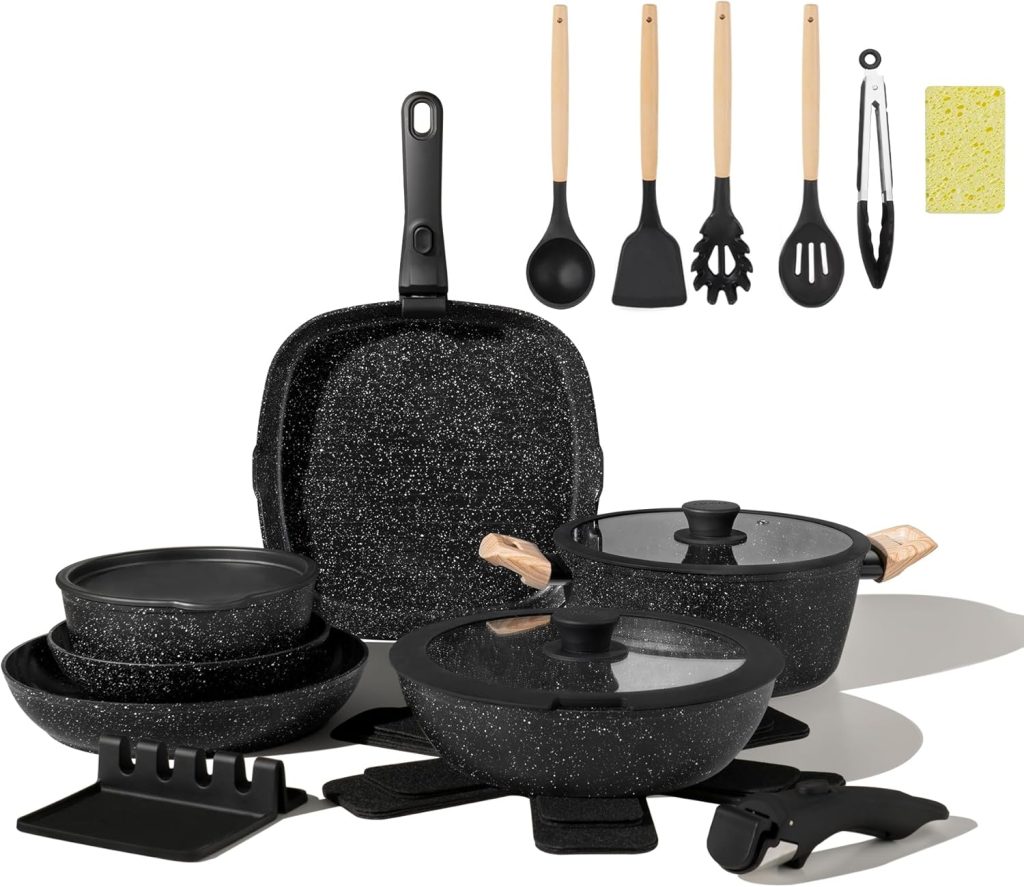
Williams Sonoma’s copper collection offers accessible luxury with good performance characteristics and attractive presentation.
Key Features:
- 2mm copper construction
- Stainless steel interior
- Brass handles with heat-resistant coating
- Oven safe to 500°F
- Available in complete sets or individual pieces
Performance Review: The performance is solid for the price point, with good heat distribution and reasonable responsiveness. The stainless steel lining is durable and easy to maintain. While not quite at the level of premium European brands, it offers good value for occasional use.
Pros:
- Accessible price point
- Attractive presentation
- Good heat distribution
- Easy maintenance
- Available in sets or individual pieces
Cons:
- Thinner copper construction
- Less heat responsiveness than premium options
- Handles can get warm during extended cooking
- Limited professional applications
Best For: Home cooks wanting attractive copper cookware without premium pricing.
6. Matfer Bourgeat Copper Cookware
Rating: ★★★★★ (4.8/5)

Matfer Bourgeat represents professional French cookware manufacturing, with copper pieces used in top restaurants worldwide.
Key Features:
- 2.5mm thick copper construction
- Stainless steel lining
- Professional-grade construction
- Oven safe to 680°F
- Used in Michelin-starred restaurants
Performance Review: The professional pedigree shows in every aspect of performance. Heat distribution is flawless, temperature response is immediate, and construction quality ensures decades of use. The stainless steel lining provides durability while maintaining the copper’s thermal properties.
Pros:
- Professional restaurant quality
- Exceptional heat performance
- Durable construction
- Proven track record in commercial kitchens
- Available in wide range of sizes
Cons:
- Professional pricing
- Heavy weight
- Requires regular maintenance
- Limited aesthetic options
Best For: Professional chefs and serious home cooks who prioritize performance over appearance.
7. Duparquet Copper Cookware
Rating: ★★★★☆ (4.6/5)

Duparquet offers American-made copper cookware with traditional construction methods and competitive pricing.
Key Features:
- 2-2.5mm copper thickness options
- Choice of tin or stainless steel lining
- Hand-forged construction
- Made in USA
- Customizable options available
Performance Review: The quality rivals European alternatives while supporting American craftsmanship. Both lining options perform well, with tin providing slightly better heat sensitivity and stainless offering easier maintenance. The hand-forged construction ensures durability.
Pros:
- American craftsmanship
- Multiple lining options
- Competitive pricing
- Customizable features
- Excellent customer service
Cons:
- Limited availability
- Longer lead times for custom pieces
- Variable quality control
- Limited aesthetic options
Best For: Cooks who value American-made products and want customization options.
8. Falk Culinair Copper Cookware
Rating: ★★★★★ (4.9/5)
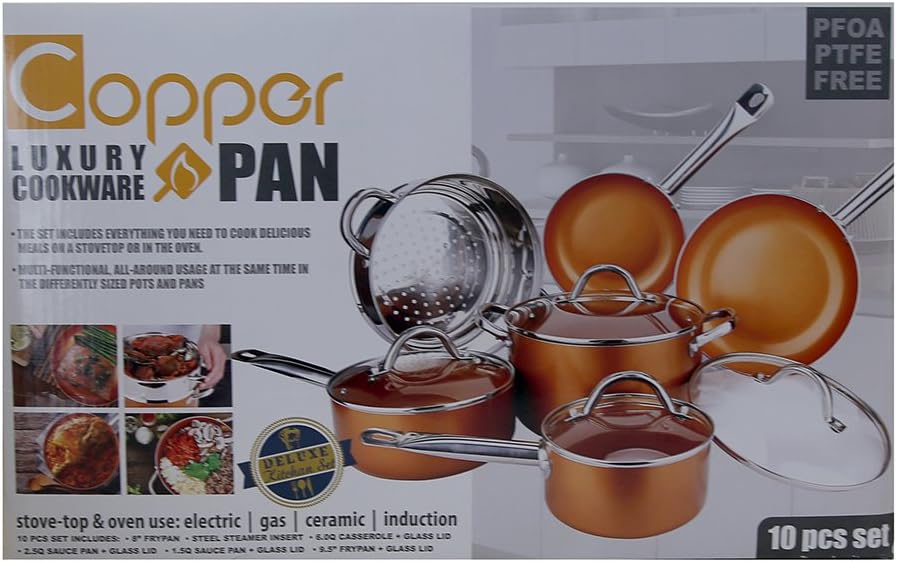
Falk Culinair represents Belgian copper craftsmanship at its finest, with innovative bimetal construction combining copper and stainless steel.
Key Features:
- 2.5mm bimetal construction (copper exterior, stainless interior)
- No separate lining—stainless steel is integral
- Suitable for all cooktops including induction
- Oven safe to 500°F
- 30-year warranty
Performance Review: The bimetal construction eliminates traditional lining issues while providing excellent heat distribution. The integral stainless steel surface offers superior durability and easy maintenance. Temperature responsiveness rivals traditional lined copper while offering modern convenience.
Pros:
- Innovative bimetal construction
- Induction compatible
- No lining to wear or repair
- Excellent heat distribution
- Long warranty period
Cons:
- Premium pricing
- Limited availability in some regions
- Heavier than traditional lined copper
- Less traditional appearance
Best For: Modern cooks who want copper performance with contemporary convenience features.
9. Bourgeat Tradition Copper Cookware
Rating: ★★★★☆ (4.5/5)
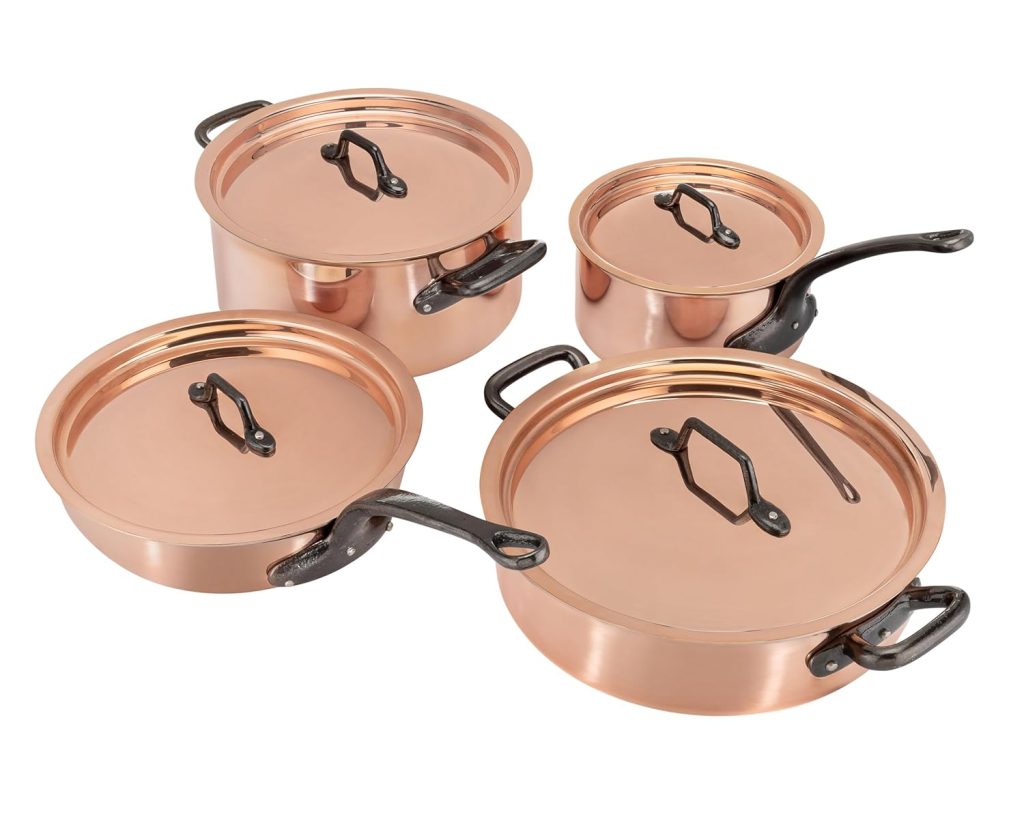
Bourgeat Tradition offers French copper craftsmanship with traditional styling and reliable performance.
Key Features:
- 2mm copper construction
- Tin lining available
- Cast iron handles
- Traditional French design
- Professional heritage
Performance Review: The traditional construction methods produce cookware with character and excellent performance. The tin lining provides superior food release and heat sensitivity. Construction quality is consistent with French professional standards.
Pros:
- Traditional French craftsmanship
- Excellent tin lining performance
- Professional quality construction
- Classic aesthetic appeal
- Reasonable pricing for quality
Cons:
- Tin lining requires careful handling
- Limited modern conveniences
- Maintenance intensive
- Not suitable for high-heat applications
Best For: Traditional cooks who appreciate authentic French copper craftsmanship.
10. Copper and Kings Handcrafted Cookware
Rating: ★★★★☆ (4.3/5)

Copper and Kings offers artisan copper cookware with unique designs and personalization options.
Key Features:
- Variable thickness options (1.5-3mm)
- Multiple lining choices
- Custom engraving available
- Hand-hammered finishes
- Small batch production
Performance Review: The performance varies with thickness options, with heavier gauges providing better heat distribution. The artisan construction means each piece is unique, though this can lead to some inconsistency. Custom options allow for personalized features.
Pros:
- Artisan craftsmanship
- Customization options
- Unique designs
- Personal service
- Competitive pricing
Cons:
- Variable quality consistency
- Limited warranty coverage
- Longer production times
- Limited professional testing
Best For: Cooks who want unique, personalized copper cookware pieces.
11. Lagostina Martellata Hammered Copper Collection
Rating: ★★★★☆ (4.4/5)

Lagostina’s Martellata line offers Italian copper cookware with distinctive hammered finish and modern functionality.
Key Features:
- Hammered copper exterior
- Stainless steel interior
- Ergonomic handles
- Oven safe to 500°F
- Dishwasher compatible
Performance Review: The hammered surface provides both aesthetic appeal and functional benefits, creating enhanced surface area for heat distribution. The stainless steel lining offers easy maintenance and food safety. Performance is good for the price point.
Pros:
- Attractive hammered finish
- Easy maintenance
- Good heat distribution
- Italian design heritage
- Moderate pricing
Cons:
- Thinner copper construction
- Less heat responsiveness than premium brands
- Limited professional applications
- Hammered surface can be difficult to clean thoroughly
Best For: Home cooks seeking attractive copper cookware with Italian styling.
12. Amoretti Brothers Traditional Copper Cookware
Rating: ★★★★★ (4.7/5)
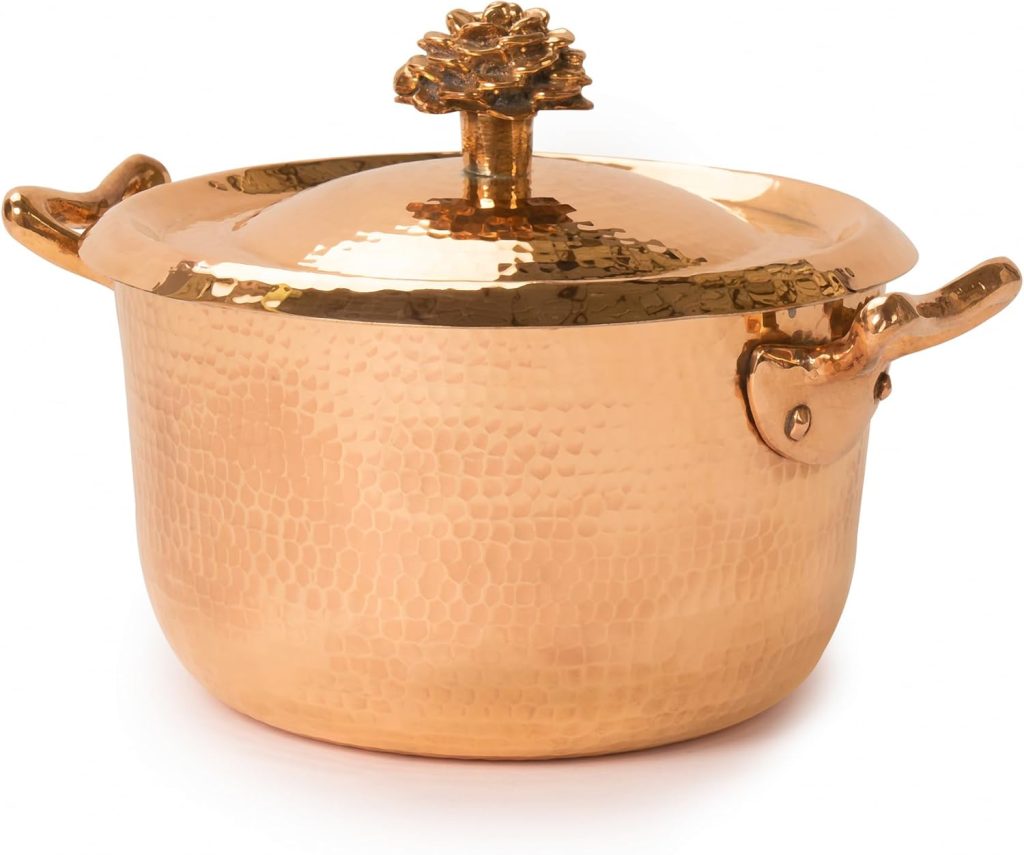
Amoretti Brothers continues Italian copper traditions with handcrafted pieces featuring exceptional attention to detail.
Key Features:
- Hand-spun copper construction
- Traditional tin lining
- Wrought iron handles
- Made in Italy
- Family craftsmanship traditions
Performance Review: The traditional construction methods produce cookware with exceptional heat sensitivity and distribution. The tin lining provides superior cooking performance, particularly for delicate sauces and proteins. Each piece reflects generations of Italian craftsmanship.
Pros:
- Authentic Italian craftsmanship
- Exceptional tin lining performance
- Traditional construction methods
- Beautiful aesthetic development over time
- Family business heritage
Cons:
- Premium pricing
- Careful temperature management required
- Maintenance intensive
- Limited modern conveniences
Best For: Collectors and traditional cooks who appreciate authentic Italian copper craftsmanship.
13. CopperBull Heavy Gauge Copper Cookware
Rating: ★★★★☆ (4.2/5)

CopperBull offers heavy gauge copper cookware with competitive pricing and solid performance characteristics.
Key Features:
- 2.5mm thick copper construction
- Stainless steel lining
- Riveted handles
- Professional weight
- Value pricing
Performance Review: The heavy gauge construction provides good heat distribution and retention. The stainless steel lining offers durability and easy maintenance. While not matching premium European brands in refinement, it offers solid performance for the price.
Pros:
- Heavy gauge construction
- Competitive pricing
- Good heat retention
- Durable construction
- Professional weight feel
Cons:
- Less refined finish than premium brands
- Variable quality control
- Limited warranty coverage
- Heavy weight may be challenging
Best For: Budget-conscious cooks who want heavy gauge copper performance.
14. Sertodo Copper Cookware Collection
Rating: ★★★★☆ (4.3/5)
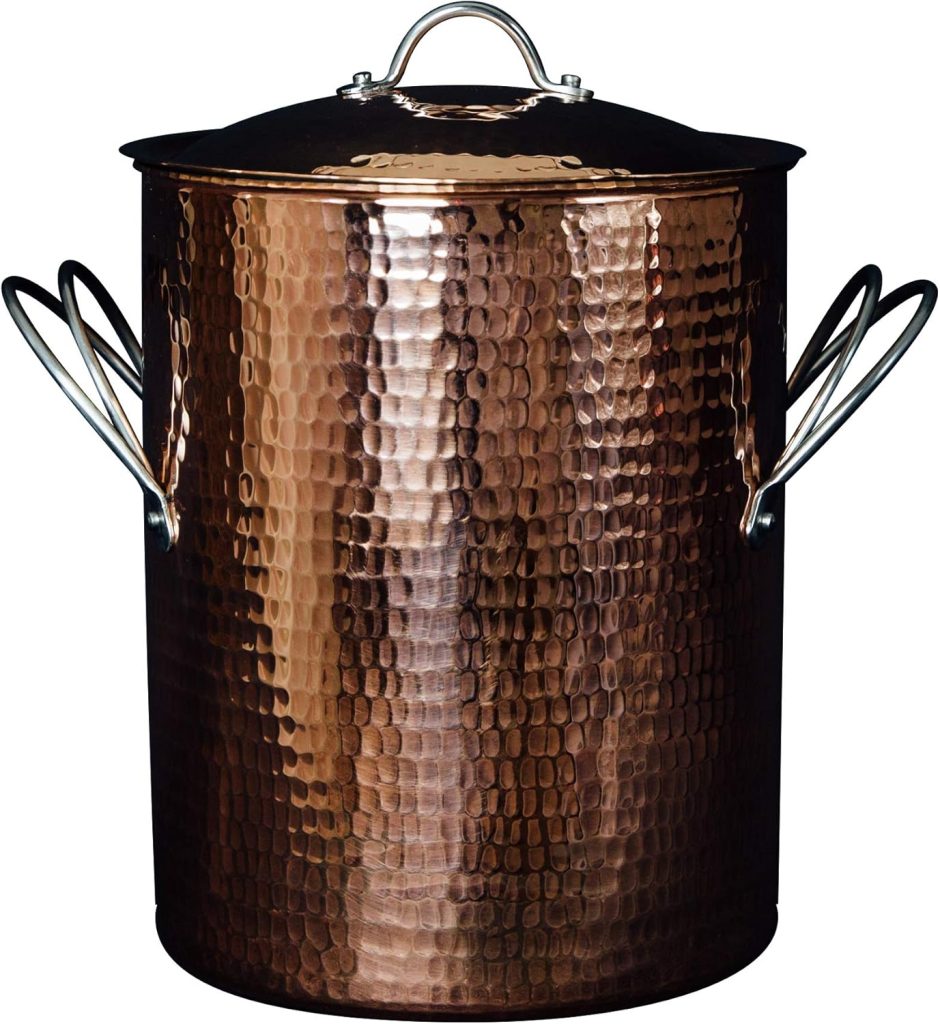
Sertodo offers Mexican copper cookware with traditional construction methods and unique aesthetic appeal.
Key Features:
- Hand-hammered construction
- Natural copper finish
- No chemical treatments
- Traditional Mexican craftsmanship
- Artisan production
Performance Review: The traditional hammered construction provides excellent heat distribution with unique aesthetic character. The natural copper finish develops beautiful patina over time. Performance is good for traditional cooking methods.
Pros:
- Authentic Mexican craftsmanship
- Beautiful natural finish development
- Traditional construction methods
- Reasonable pricing
- Unique aesthetic appeal
Cons:
- No interior lining (requires seasoning)
- Limited modern conveniences
- Requires careful maintenance
- Not suitable for all cooking applications
Best For: Traditional cooks who appreciate authentic Mexican copper craftsmanship and don’t mind extra maintenance.
15. Old Dutch International Copper Cookware
Rating: ★★★☆☆ (3.8/5)

Old Dutch offers affordable copper cookware with basic functionality and attractive appearance.
Key Features:
- Thin gauge copper construction
- Stainless steel lining
- Basic construction
- Affordable pricing
- Wide availability
Performance Review: The thin gauge construction provides limited heat performance compared to professional-grade options. Suitable for light cooking tasks but lacks the responsiveness and durability of heavier gauge alternatives. Good for occasional use or decorative purposes.
Pros:
- Very affordable pricing
- Wide retail availability
- Basic functionality
- Attractive appearance when new
- Light weight for easy handling
Cons:
- Thin gauge provides poor heat performance
- Limited durability
- Poor heat distribution
- Not suitable for serious cooking
- Quality control issues
Best For: Casual cooks on tight budgets or those wanting copper appearance without performance requirements.
16. NuWave Copper Cookware Set
Rating: ★★★☆☆ (3.5/5)

NuWave offers copper-colored cookware with ceramic non-stick coating, though it’s not true copper construction.
Key Features:
- Aluminum base with copper-colored coating
- Ceramic non-stick interior
- Induction compatible
- Dishwasher safe
- Affordable pricing
Performance Review: Despite the copper appearance, this is aluminum cookware with copper-colored coating. The ceramic non-stick surface provides easy food release but lacks the heat characteristics of true copper. Performance is adequate for basic cooking needs.
Pros:
- Very affordable
- Non-stick surface
- Easy cleanup
- Induction compatible
- Lightweight construction
Cons:
- Not true copper construction
- Limited heat performance
- Non-stick coating wears over time
- Misleading copper marketing
- Poor heat retention
Best For: Budget-conscious cooks who want copper appearance with non-stick convenience.
17. Viking Copper Cookware Collection
Rating: ★★★★☆ (4.1/5)
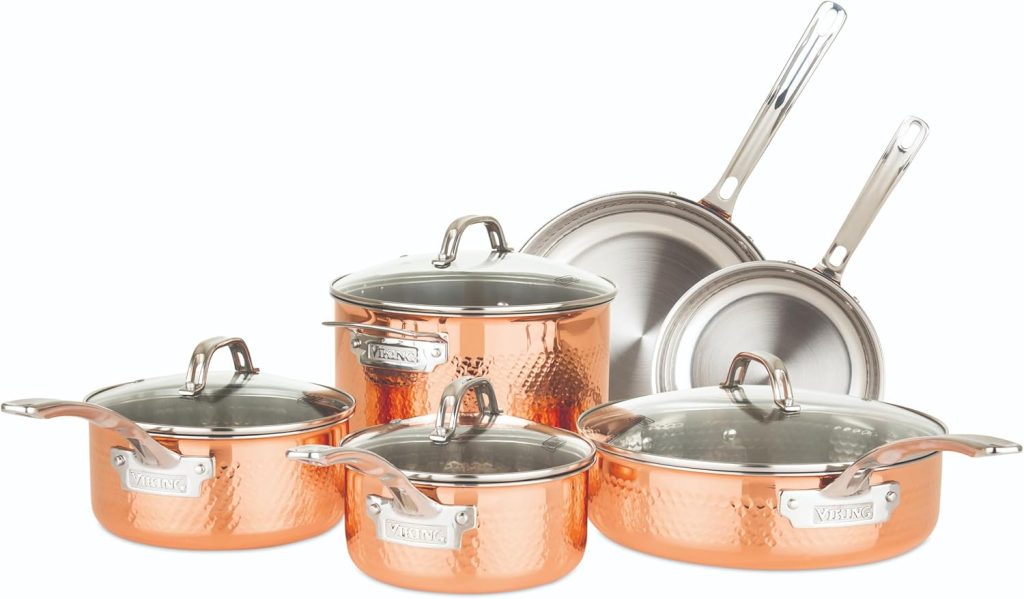
Viking’s copper line offers professional styling with good performance characteristics at moderate pricing.
Key Features:
- 2mm copper construction
- Stainless steel interior
- Professional appearance
- Oven safe to 600°F
- Available in complete sets
Performance Review: The 2mm construction provides reasonable heat distribution though not quite matching thicker gauge alternatives. The stainless steel lining offers durability and easy maintenance. Good performance for the price point with professional styling.
Pros:
- Professional appearance
- Good heat distribution
- Moderate pricing
- Available in sets
- Brand reputation
Cons:
- Thinner copper construction
- Less heat responsiveness than premium options
- Limited warranty coverage
- Heavy marketing focus over performance
Best For: Home cooks who want professional styling with reasonable performance.
18. Spring Switzerland Copper Cookware
Rating: ★★★★★ (4.6/5)
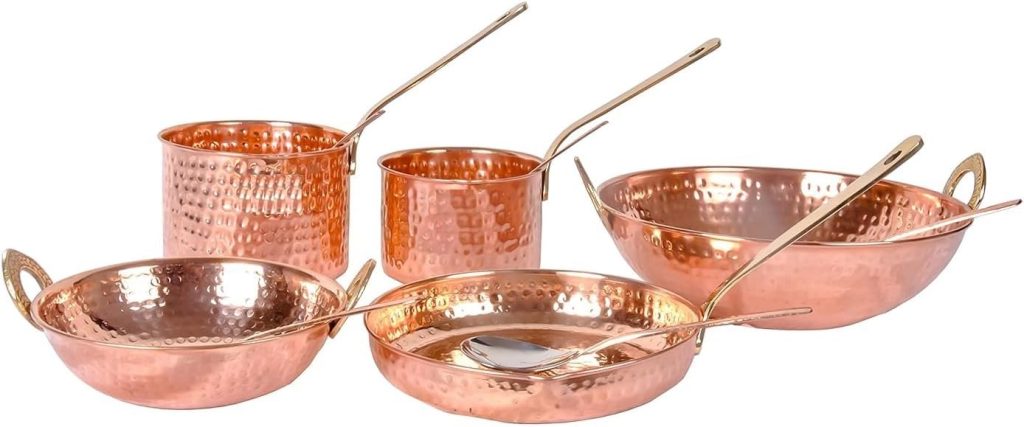
Spring Switzerland offers precision-engineered copper cookware with Swiss quality standards and innovative features.
Key Features:
- Precision copper construction
- Multiple lining options
- Swiss engineering standards
- Temperature-responsive handles
- Lifetime craftsmanship warranty
Performance Review: Swiss precision shows in every aspect of construction and performance. Heat distribution is exceptional, and innovative features like temperature-responsive handles add practical value. The quality justifies the premium pricing.
Pros:
- Swiss precision engineering
- Innovative features
- Excellent heat performance
- Lifetime warranty
- Superior construction quality
Cons:
- Premium pricing
- Limited availability
- Heavy weight
- Requires proper maintenance
Best For: Precision-oriented cooks who appreciate Swiss engineering and innovative features.
19. Calphalon Copper Cookware Line
Rating: ★★★☆☆ (3.9/5)
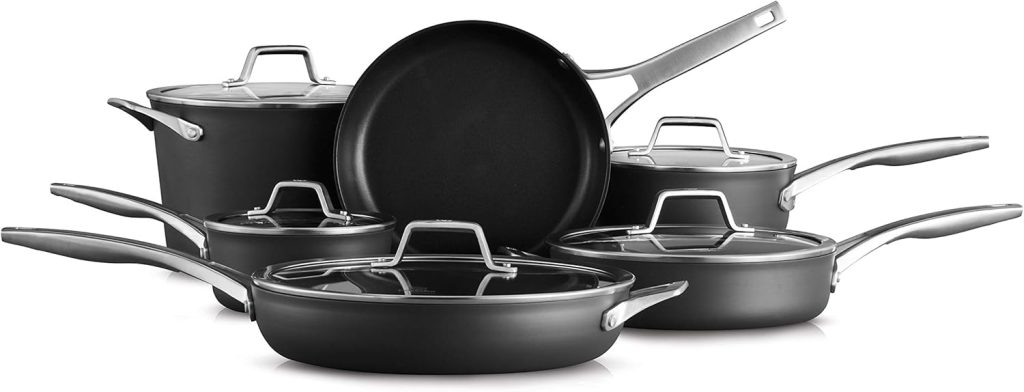
Calphalon offers copper-accented cookware that combines copper elements with other materials for improved affordability.
Key Features:
- Copper base with aluminum sides
- Non-stick interior options
- Modern styling
- Dishwasher safe
- Mass market availability
Performance Review: The copper base provides some heat benefits, though the aluminum sides limit overall copper performance. The non-stick options offer convenience but reduce the traditional copper cooking experience. Adequate for general cooking needs.
Pros:
- Affordable pricing
- Wide availability
- Modern conveniences
- Easy maintenance
- Various size options
Cons:
- Limited copper content
- Reduced heat performance
- Non-stick coating limitations
- Not true copper construction
- Marketing over substance
Best For: Mainstream cooks who want some copper benefits with modern convenience features.
20. Scanpan CTX Copper Cookware
Rating: ★★★★☆ (4.3/5)
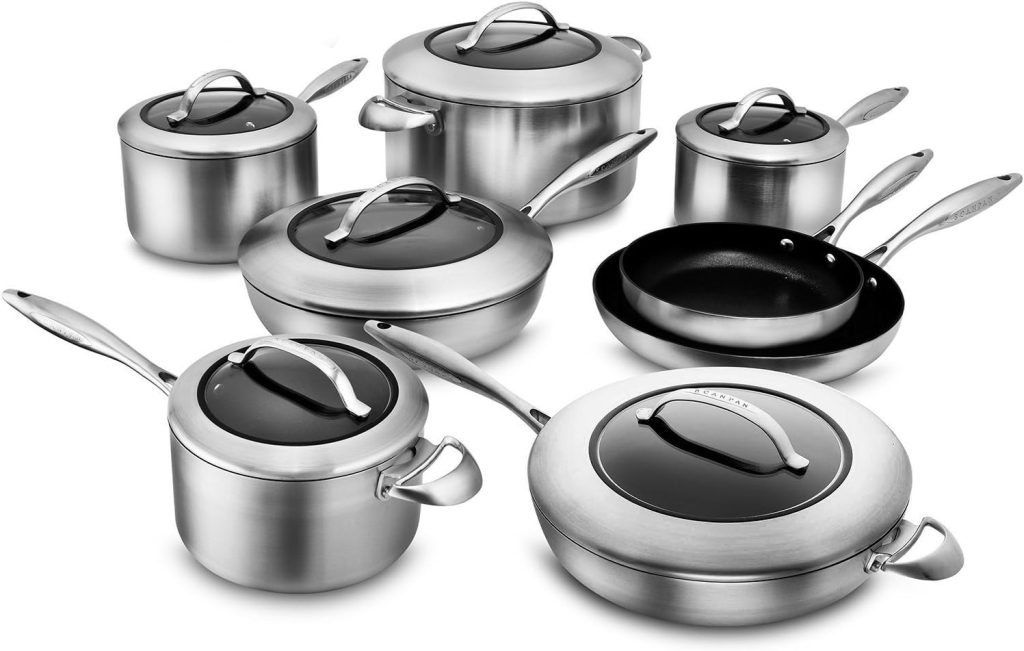
Scanpan CTX combines copper with stainless steel in Danish-engineered cookware with professional performance characteristics.
Key Features:
- Copper core with stainless steel layers
- Stratanium non-stick surface
- Induction compatible
- Oven safe to 500°F
- Danish design heritage
Performance Review: The copper core provides good heat distribution while the stainless steel layers add durability. The Stratanium surface offers excellent food release without traditional non-stick coating drawbacks. Well-engineered combination of materials.
Pros:
- Excellent heat distribution
- Durable non-stick surface
- Induction compatible
- Danish quality standards
- Professional performance
Cons:
- Premium pricing
- Limited copper content visibility
- Heavy construction
- Requires proper heating techniques
Best For: Professional cooks who want copper performance with modern non-stick convenience.
21. De Buyer Prima Matera Copper Collection
Rating: ★★★★★ (4.8/5)

De Buyer’s Prima Matera represents French copper excellence with traditional construction and modern functionality.
Key Features:
- 2.5mm copper construction
- Stainless steel lining
- Traditional French craftsmanship
- Professional kitchen heritage
- Multiple size options
Performance Review: The thick copper construction provides exceptional heat distribution and responsiveness. French craftsmanship ensures consistent quality and durability. The stainless steel lining balances performance with practicality.
Pros:
- Excellent heat performance
- Traditional French quality
- Professional kitchen proven
- Durable construction
- Beautiful aesthetic development
Cons:
- Premium pricing
- Heavy weight
- Requires maintenance
- Learning curve for optimal use
Best For: Serious cooks who want authentic French copper cookware with professional performance.
22. Cuisinart Copper Collection
Rating: ★★★☆☆ (3.6/5)

Cuisinart offers accessible copper cookware with mainstream appeal and competitive pricing.
Key Features:
- Copper exterior with aluminum core
- Stainless steel cooking surface
- Dishwasher safe
- Mass market availability
- Moderate pricing
Performance Review: The copper exterior provides attractive appearance while the aluminum core handles heat distribution. Performance is adequate for general cooking though lacks the responsiveness of solid copper construction. Good entry-level option.
Pros:
- Affordable pricing
- Widely available
- Easy maintenance
- Attractive appearance
- Brand recognition
Cons:
- Limited copper benefits
- Thin construction
- Poor heat retention
- Not professional grade
- Marketing emphasis over performance
Best For: Casual cooks who want copper appearance at accessible pricing.
Complete Buying Guide
Understanding Copper Cookware Construction
Copper cookware construction varies significantly between manufacturers and price points, directly impacting performance and durability. Understanding these differences is crucial for making an informed purchase decision.
Copper Thickness (Gauge)
The thickness of copper, measured in millimeters, is the most critical factor determining cookware performance. Professional-grade copper cookware typically ranges from 2.5mm to 3mm thick, providing optimal heat distribution and retention. Thinner gauges (1.5-2mm) offer some copper benefits at lower cost but compromise performance. Ultra-thin copper (under 1.5mm) provides minimal functional benefit and is primarily decorative.
Thicker copper responds more slowly to temperature changes but provides better heat retention and more even distribution. This makes it ideal for techniques requiring steady, consistent heat like braising or sauce-making. Thinner copper responds more quickly but may develop hot spots and provides less heat retention.
Interior Lining Options
Modern copper cookware requires interior lining to prevent copper from leaching into food. The three primary lining materials each offer distinct advantages:
Stainless Steel Lining is the most common and practical choice. It provides durability, easy maintenance, and food safety without affecting flavor. Quality stainless steel linings use 18/10 stainless steel (18% chromium, 10% nickel) for optimal corrosion resistance and non-reactivity. This lining can withstand high temperatures and aggressive cleaning without degradation.
Tin Lining represents the traditional choice, offering superior heat sensitivity and food release properties. Many professional chefs prefer tin for its cooking characteristics, particularly for delicate sauces and proteins. However, tin requires careful temperature management (never exceeding 425°F) and periodic re-tinning as it wears over time.
Silver Lining is rare and expensive but offers the ultimate in heat conductivity and food release. It combines the benefits of tin with greater durability but at significantly higher cost. Silver-lined copper is typically found only in premium artisan pieces.
Handle Construction and Materials
Handle construction significantly impacts both performance and safety. Traditional copper cookware often features cast iron handles that become very hot during cooking, requiring pot holders for safe handling. These handles are oven-safe to high temperatures and distribute weight evenly.
Modern copper cookware may feature stainless steel handles with heat-resistant coatings or hollow construction to reduce heat transfer. Some manufacturers use bronze or brass handles for aesthetic appeal and moderate heat resistance. The attachment method—whether riveted, welded, or screwed—affects durability and cleaning ease.
Manufacturing Methods
Traditional copper cookware is hand-spun or hand-hammered, creating pieces with character and slight variations. This artisan approach typically results in superior quality and attention to detail but higher costs and longer production times.
Machine-manufactured copper cookware offers consistency and lower costs but may lack the refinement of handcrafted pieces. Quality machine-made copper can still perform excellently while being more accessible to home cooks.
Performance Characteristics
Heat Conductivity and Distribution
Copper’s exceptional thermal conductivity—five times greater than iron and twenty times greater than stainless steel—creates unparalleled heat distribution across the cooking surface. This eliminates hot spots that can cause uneven cooking or burning in inferior cookware materials.
The rapid heat transfer allows for immediate temperature response when adjusting burner settings. This responsiveness is particularly valuable for techniques requiring precise temperature control, such as making delicate sauces, caramel, or chocolate work.
Temperature Responsiveness
Quality copper cookware responds almost instantly to heat source changes, allowing for precise control over cooking temperatures. This responsiveness enables techniques impossible with other materials, such as quickly reducing heat to prevent sauce breaking or rapidly increasing temperature for proper searing.
The temperature responsiveness also provides energy efficiency, as the cookware quickly reaches desired temperatures and maintains them with less energy input than other materials.
Heat Retention Properties
While copper heats quickly, it also cools relatively quickly compared to materials like cast iron. This characteristic is actually beneficial for most cooking applications, preventing carryover cooking and allowing for better control over final results.
The rapid cooling can be advantageous when stopping cooking processes precisely, such as when making custards or other temperature-sensitive preparations.
Compatibility Considerations
Cooktop Compatibility
Traditional copper cookware is compatible with gas and electric cooktops but not induction. The non-magnetic properties of copper prevent induction cooktops from generating heat in copper cookware. Some modern copper cookware includes induction-compatible bases or cores to address this limitation.
Gas cooktops provide ideal heat source characteristics for copper cookware, allowing for infinite heat adjustment and flame patterns that complement copper’s heat distribution properties. Electric cooktops work well but may not provide the same level of heat control as gas.
Oven Safety
Most copper cookware is oven-safe to temperatures ranging from 450°F to 680°F, depending on handle materials and construction. Cast iron handles typically allow the highest oven temperatures, while coated or composite handles may have lower temperature limits.
Always verify oven safety ratings for specific pieces, as manufacturers’ specifications vary. Some copper cookware with tin lining has lower oven temperature limits due to tin’s melting point.
Dishwasher Considerations
While some copper cookware is labeled dishwasher-safe, hand washing is generally recommended to preserve appearance and prevent damage to protective coatings or linings. Dishwasher detergents can be harsh on copper surfaces and may cause discoloration or pitting over time.
The high heat and harsh chemicals in dishwashers can also damage handle materials or loosen riveted connections, particularly in lower-quality pieces.
Quality Assessment Criteria
Construction Quality Indicators
High-quality copper cookware exhibits several distinguishable characteristics. The copper should feel substantial and heavy, indicating adequate thickness for proper heat distribution. Surfaces should be smooth and even, without pits, scratches, or irregularities that could affect performance.
Handle attachment should be secure and even, with rivets or welds showing consistent, professional workmanship. Interior lining should be smooth and evenly applied, without bubbles, gaps, or thin spots that could lead to premature failure.
Weight and Balance
Professional-grade copper cookware has substantial weight that reflects the thickness of copper construction. A properly balanced piece should feel stable when held, with weight distributed evenly between the pan and handle. This balance prevents tipping and provides comfortable handling during cooking.
Lighter-weight copper cookware often indicates thinner construction that compromises heat distribution and durability. However, some cooks prefer lighter pieces for easier handling, particularly in larger sizes.
Finish Quality and Consistency
The copper finish should be even and consistent, whether polished, hammered, or naturally oxidized. Any decorative elements should be well-executed and integral to the construction rather than applied coatings that might wear or chip.
Interior lining should be smoothly applied with consistent thickness and no visible defects. The transition between copper exterior and interior lining should be seamless and well-finished.
Investment Considerations
Price vs. Value Analysis
Copper cookware represents a significant investment, with quality pieces ranging from moderate to very expensive. The key is understanding the relationship between price and actual performance benefits rather than simply choosing the most expensive option.
Professional-grade copper from established manufacturers typically provides the best long-term value, combining performance, durability, and resale value. Artisan pieces may cost more but offer unique characteristics and personal satisfaction beyond pure performance metrics.
Budget options may provide some copper benefits but often compromise on thickness, construction quality, or lining durability. These pieces can serve as introduction to copper cookware but may not provide the full experience or longevity of higher-grade alternatives.
Longevity and Durability
Quality copper cookware can last generations with proper care and maintenance. The copper itself is virtually indestructible, and even worn linings can be professionally restored. This longevity makes copper cookware an excellent investment for serious cooks.
The durability depends heavily on construction quality and maintenance practices. Well-made pieces with proper care can remain functional and attractive for decades, while poor-quality or neglected pieces may show wear within years.
Resale Value Considerations
Premium copper cookware typically retains value well, particularly pieces from established manufacturers or artisan makers. Vintage copper cookware often commands high prices among collectors and professional cooks, indicating strong resale potential.
The condition and maintenance history significantly affect resale value. Well-maintained pieces with intact lining and minimal wear retain the highest value, while neglected pieces may require restoration to achieve fair market value.
Size and Configuration Options
Individual Piece Selection
Building a copper cookware collection piece by piece allows for careful selection of sizes and types that match specific cooking needs. This approach enables investment in higher-quality pieces while focusing on most-used items first.
Common starting pieces include a saucepan, sauté pan, and stockpot, providing versatility for most cooking tasks. Additional pieces can be added as needs and budget allow, creating a customized collection over time.
Complete Set Benefits and Drawbacks
Complete sets offer consistency in construction and appearance while providing potential cost savings compared to individual piece purchases. Sets ensure matching aesthetic and performance characteristics across all pieces.
However, sets often include pieces that may not be used frequently, reducing overall value. Some sets compromise on individual piece optimization to maintain consistent pricing across the collection.
Specialty Pieces and Applications
Copper excels in specific cooking applications that may justify specialty pieces. Items like jam pans, zabaglione pans, or sugar pots take advantage of copper’s unique heat characteristics for specialized techniques.
These specialty pieces often represent the highest expression of copper cookware benefits but serve narrow purposes. They’re best considered after establishing a foundation of general-purpose pieces.
Brand Reputation and Warranties
Established Manufacturers
Well-established copper cookware manufacturers typically offer consistent quality, established customer service, and proven longevity. Brands with decades or centuries of experience have refined their manufacturing processes and understand the nuances of copper construction.
French manufacturers like Mauviel and Matfer Bourgeat have supplied professional kitchens for generations, providing proven performance records. Italian artisans like Amoretti Brothers maintain traditional craftsmanship methods that produce unique, high-quality pieces. American manufacturers like Brooklyn Copper Cookware combine traditional techniques with modern quality standards.
Warranty Coverage and Support
Warranty terms vary significantly between manufacturers and reflect confidence in construction quality. Premium manufacturers often offer lifetime warranties on construction defects, though normal wear items like tin lining may have separate coverage terms.
Understanding warranty coverage is crucial, particularly regarding lining replacement, handle repair, and defect remediation. Some manufacturers offer re-tinning services for traditional tin-lined pieces, extending product life indefinitely.
Customer support quality varies between manufacturers, with artisan producers often providing personal service while mass-market brands may offer more standardized support systems. Consider support availability and responsiveness when making investment decisions.
Frequently Asked Questions
General Copper Cookware Questions
Q: Is copper cookware safe to use?
A: Modern copper cookware with proper interior lining is completely safe for cooking. The lining prevents copper from leaching into food while maintaining the heat transfer benefits of copper construction. Unlined copper should not be used for cooking acidic foods or storage, as it can cause copper toxicity.
Q: Why is copper cookware so expensive?
A: Several factors contribute to copper cookware’s cost. The raw copper material is expensive, and quality cookware requires significant amounts. Manufacturing processes are often labor-intensive, particularly for handcrafted pieces. The specialized skills required for proper copper construction limit the number of qualified manufacturers. Finally, the superior performance characteristics and longevity justify premium pricing for serious cooks.
Q: Does copper cookware work on induction cooktops?
A: Traditional copper cookware is not induction-compatible because copper is non-magnetic. However, some modern copper cookware includes induction-compatible bases or cores that work with induction cooktops. Always verify induction compatibility if this is a requirement for your kitchen.
Q: How long does copper cookware last?
A: Quality copper cookware can last generations with proper care. The copper itself is virtually indestructible, and even worn interior linings can be professionally restored. Well-maintained pieces from the early 1900s are still functional today, demonstrating the potential longevity of quality construction.
Q: What’s the difference between hammered and smooth copper cookware?
A: Hammered copper features a textured surface created by hand-hammering during manufacture. This texture can enhance heat distribution by creating additional surface area and adds aesthetic appeal. Smooth copper provides easier cleaning and a more contemporary appearance. Both styles perform similarly when construction quality is equivalent.
Performance and Cooking Questions
Q: What types of cooking benefit most from copper cookware?
A: Copper excels in applications requiring precise temperature control and even heat distribution. This includes sauce-making, candy and chocolate work, braising, and delicate protein preparations. The immediate temperature response allows for techniques impossible with other materials, such as rapidly stopping cooking processes or making temperature-sensitive emulsions.
Q: Can I use high heat with copper cookware?
A: Copper cookware can handle high heat, but the excellent heat conduction means high settings are rarely necessary. Medium heat settings often produce results equivalent to high heat in other materials. For tin-lined pieces, temperatures should not exceed 425°F to prevent lining damage. Always consult manufacturer guidelines for specific temperature limits.
Q: Does food stick to copper cookware?
A: Properly heated and maintained copper cookware with quality lining should not have significant sticking issues. Stainless steel-lined pieces may require proper preheating and fat addition, similar to other stainless cookware. Tin-lined pieces often provide superior food release properties, particularly for delicate items like fish or eggs.
Q: How do I prevent copper cookware from tarnishing?
A: Copper naturally develops patina over time, which many consider attractive. To maintain bright copper appearance, regular cleaning with copper polish or acid-based cleaners is necessary. However, tarnish doesn’t affect cooking performance, and many chefs prefer the developed patina of well-used pieces.
Q: Can I use copper cookware for all types of cooking?
A: Copper cookware is versatile and suitable for most cooking techniques. However, it’s not ideal for long-term food storage due to potential reactivity. Some acidic foods may affect certain lining materials over time. For general cooking applications, quality copper cookware performs excellently across a wide range of techniques.
Maintenance and Care Questions
Q: How do I clean copper cookware properly?
A: Regular cleaning involves washing with warm soapy water and soft sponges or cloths. Avoid abrasive cleaners or scrubbers that could damage lining or scratch surfaces. For exterior cleaning, copper-specific cleaners or home remedies like salt and lemon can restore shine. Always dry thoroughly to prevent water spots and corrosion.
Q: How often should I polish copper cookware?
A: Polishing frequency depends on personal preference and usage patterns. Some cooks polish after each use to maintain bright appearance, while others prefer the natural patina development. For functional purposes, polishing is not necessary for performance, but it maintains aesthetic appeal and prevents excessive oxidation.
Q: What should I do if the interior lining gets damaged?
A: Minor scratches in stainless steel lining are usually cosmetic and don’t affect function. Deep scratches or exposed copper require professional evaluation. Tin lining naturally wears over time and can be professionally restored through re-tinning services. Never use damaged cookware where copper is exposed to food contact areas.
Q: Can I put copper cookware in the dishwasher?
A: While some copper cookware is labeled dishwasher-safe, hand washing is recommended to preserve appearance and prevent damage. Dishwasher detergents can be harsh on copper surfaces and may cause discoloration. The high heat environment can also affect handle materials or loosen connections over time.
Q: How do I store copper cookware properly?
A: Store copper cookware in dry conditions with adequate ventilation to prevent moisture accumulation. Avoid stacking pieces directly against each other without protection to prevent scratching. Soft cloth dividers or protective pads between pieces help maintain surface quality. Hanging storage works well for frequently used pieces and provides attractive display.
Buying and Selection Questions
Q: What thickness of copper should I look for?
A: For optimal performance, look for copper thickness of 2.5-3mm in professional-grade cookware. This provides the best heat distribution and retention characteristics. Thinner copper (1.5-2mm) offers some benefits at lower cost but compromises performance. Avoid very thin copper (under 1.5mm) that provides minimal functional benefit.
Q: Should I buy a complete set or individual pieces?
A: Individual piece selection allows for higher quality investment in most-used items and customization to specific needs. Complete sets offer consistency and potential cost savings but may include pieces you won’t use frequently. Consider starting with essential pieces and expanding over time based on actual usage patterns.
Q: What’s the difference between tin and stainless steel lining?
A: Tin lining provides superior heat sensitivity and food release properties, particularly for delicate applications. However, it requires careful temperature management and periodic re-tinning. Stainless steel lining offers durability, easy maintenance, and higher temperature tolerance but may not provide quite the same cooking sensitivity as tin.
Q: Are there good budget options for copper cookware?
A: Budget copper options exist but often compromise on thickness, construction quality, or lining durability. These pieces can provide an introduction to copper cookware but may not deliver the full performance benefits. Consider investing in one quality piece rather than a complete set of budget options to experience true copper performance.
Q: What should I look for when buying vintage copper cookware?
A: Examine vintage pieces carefully for construction quality, lining condition, and overall wear. Look for adequate copper thickness, secure handle attachment, and intact interior lining. Vintage pieces may require professional restoration, particularly re-tinning for tin-lined pieces. Verify the maker and assess whether restoration costs justify the investment.
Technical and Safety Questions
Q: Is there a risk of copper poisoning from cookware?
A: Properly lined modern copper cookware poses no risk of copper poisoning. The interior lining prevents copper from leaching into food. Only unlined copper or cookware with damaged lining could present risks, particularly with acidic foods. Always use cookware with intact, food-safe lining materials.
Q: Why do some recipes specifically call for copper cookware?
A: Certain culinary techniques benefit from copper’s unique heat characteristics. Sugar work and candy making rely on precise temperature control that copper provides. Delicate sauces like hollandaise or béarnaise benefit from immediate temperature response. Traditional French cooking techniques were developed using copper cookware and may not work as well with other materials.
Q: How does copper cookware compare to other premium materials?
A: Copper offers the best heat conductivity and temperature responsiveness of any cookware material. Cast iron provides better heat retention but slower response. High-end stainless steel offers durability and convenience but less heat performance. Carbon steel provides good heat properties with lighter weight but requires more maintenance than copper.
Q: Can I repair copper cookware myself?
A: Minor cosmetic issues like tarnishing can be addressed with appropriate cleaning products. However, structural repairs, lining restoration, or handle reattachment should be performed by professionals experienced with copper cookware. Improper repairs can compromise safety and performance while potentially voiding warranties.
Q: What accessories do I need for copper cookware?
A: Basic accessories include appropriate cleaning materials like copper polish and soft cloths. Pot holders or trivets are essential for handling hot copper cookware, particularly pieces with iron handles. Storage protection like soft cloth dividers helps maintain surface quality. Some cooks invest in specialized tools for re-tinning or restoration services.
Maintenance and Care Tips
Daily Care and Cleaning
Proper daily care ensures copper cookware maintains both performance and appearance throughout its lifetime. The cleaning approach depends on the interior lining material and desired appearance level.
Basic Cleaning Protocol
After each use, allow copper cookware to cool completely before cleaning. Hot copper can warp or sustain thermal shock when exposed to cold water. Once cool, wash with warm soapy water using soft sponges or cloths. Avoid abrasive materials that could scratch the interior lining or exterior copper surface.
For stainless steel-lined pieces, standard dish soap effectively removes food residues and oils. Pay particular attention to the rim area where copper and lining meet, as food particles can accumulate in this junction. Rinse thoroughly with clean water and dry immediately with soft towels to prevent water spots and mineral deposits.
Tin-lined pieces require gentler cleaning approaches. Use mild dish soap and avoid harsh scrubbing that could wear the tin lining prematurely. Tin naturally develops a patina that actually improves cooking performance, so aggressive cleaning is counterproductive.
Dealing with Stubborn Residues
For stuck-on food or burnt residues, create a paste using baking soda and water. Apply this paste to affected areas and allow it to sit for 15-20 minutes before gentle scrubbing with soft cloths. This method effectively removes residues without damaging lining materials.
Never use steel wool, abrasive cleansers, or harsh chemicals on copper cookware. These materials can permanently damage both interior lining and exterior copper surfaces. For persistent residues, soaking in warm soapy water followed by gentle scrubbing is safer than aggressive cleaning methods.
Commercial copper cleaners can address exterior staining but should never be used on interior cooking surfaces. Always rinse thoroughly after using any cleaning products to prevent residue buildup that could affect food flavor or safety.
Exterior Maintenance and Polishing
The exterior copper finish requires different care depending on desired appearance and usage patterns. Some cooks prefer the natural patina development, while others maintain bright copper appearance through regular polishing.
Natural Patina Development
Copper naturally develops patina through exposure to air and handling. This patina progression moves from bright copper through various brown and green hues, eventually settling into an attractive aged appearance. This patina is protective and doesn’t affect cooking performance.
To encourage even patina development, allow the cookware to air dry completely after washing. Uneven drying can create splotchy patina patterns that some find unattractive. Regular use and gentle handling promote attractive patina development over time.
Many professional chefs prefer patinated copper for its proven use appearance and reduced maintenance requirements. The patina indicates seasoned cookware that has developed optimal cooking characteristics through use.
Maintaining Bright Copper Finish
For those preferring bright copper appearance, regular polishing maintains the lustrous finish. Commercial copper cleaners effectively remove oxidation and restore shine when used according to manufacturer directions.
Home remedies can also effectively clean copper surfaces. A paste made from equal parts salt and lemon juice creates an effective, natural copper cleaner. Apply this paste with soft cloths, working in circular motions to remove oxidation and staining. Rinse thoroughly and dry immediately after cleaning.
Another effective home remedy combines equal parts flour, salt, and white vinegar to create a cleaning paste. This mixture effectively removes tarnish while being gentle on copper surfaces. Always test cleaning methods on inconspicuous areas before applying to entire surfaces.
Protective Treatments
Some manufacturers offer protective treatments that slow patina development and reduce maintenance requirements. These treatments typically involve thin, clear coatings that preserve bright copper appearance while reducing oxidation rates.
However, protective coatings may affect heat transfer characteristics and can wear unevenly over time, creating patchy appearances. Consider whether reduced maintenance justifies potential performance compromises and aesthetic risks.
Long-term Maintenance Considerations
Lining Inspection and Maintenance
Regular inspection of interior lining condition prevents safety issues and maintains optimal cooking performance. Stainless steel lining should be examined for deep scratches, pitting, or areas where copper might be exposed. Minor scratches are normal and don’t affect function, but deep damage requires professional evaluation.
Tin lining naturally wears over time and requires periodic replacement. Signs of tin lining wear include dark spots where copper shows through, rough texture development, or areas where tin has worn completely away. Professional re-tinning services can restore tin-lined pieces to like-new condition.
The frequency of re-tinning depends on usage patterns and care practices. Professional kitchens may require re-tinning every few years, while home cooks might need service every decade or more. Proper care and appropriate heat levels extend tin lining life significantly.
Handle Maintenance
Handle materials require specific maintenance approaches depending on construction. Cast iron handles develop rust if exposed to moisture, so thorough drying after washing is essential. Light rust can be removed with fine steel wool and prevented with light oil coating during storage.
Stainless steel handles typically require minimal maintenance but should be checked periodically for loose rivets or connections. Any looseness should be professionally addressed before it becomes a safety issue.
Coated handles may show wear over time, particularly in high-use areas. While cosmetic wear doesn’t affect function, significant coating loss may compromise heat protection and grip security.
Storage and Protection
Proper storage protects copper cookware from damage and extends its useful life. Store pieces in dry conditions with adequate ventilation to prevent moisture accumulation that could promote corrosion or tarnishing.
When stacking copper pieces, use soft cloth dividers or protective pads to prevent scratching. The relatively soft copper surface can be easily damaged by contact with harder materials or rough handling.
Hanging storage works well for frequently used pieces and provides attractive kitchen display. Ensure hanging hardware is adequate for the substantial weight of copper cookware and won’t damage handles or attachment points.
Professional Services and Restoration
When to Seek Professional Help
Certain maintenance tasks require professional expertise to ensure safety and preserve cookware value. Structural repairs, lining replacement, or handle reattachment should always be performed by experienced craftspeople familiar with copper construction techniques.
Signs requiring professional attention include loose handles, damaged interior lining exposing copper, dents or deformation affecting function, or any condition that could compromise food safety. Attempting DIY repairs on expensive copper cookware often causes more damage than the original problem.
Re-tinning Services
For tin-lined copper cookware, professional re-tinning services restore cooking performance and extend useful life indefinitely. Quality re-tinning involves complete removal of old tin, thorough cleaning of copper surfaces, and application of new tin lining using traditional techniques.
Locate re-tinning services through specialty cookware retailers, culinary schools, or online directories. Verify the service provider’s experience with copper cookware and request examples of their work before committing to expensive pieces.
Restoration and Repair Services
Professional restoration can return damaged or neglected copper cookware to functional condition. Services may include dent repair, handle replacement, surface refinishing, and complete rebuilding of severely damaged pieces.
Consider restoration costs against replacement costs when evaluating damaged pieces. High-quality vintage or artisan pieces may justify significant restoration expenses, while mass-produced pieces might be more economical to replace.
Conclusion
Copper cookware represents the pinnacle of culinary equipment, offering unmatched heat performance and timeless aesthetic appeal. The investment in quality copper cookware pays dividends through superior cooking results, exceptional durability, and the satisfaction of owning authentic professional-grade equipment.
The key to successful copper cookware ownership lies in understanding the different construction methods, lining materials, and maintenance requirements. Whether choosing traditional tin-lined pieces for ultimate cooking sensitivity or modern stainless steel-lined cookware for convenience, the fundamental benefits of copper’s superior heat characteristics remain constant.
When selecting copper cookware, prioritize thickness and construction quality over superficial features. A single, high-quality piece will provide better value and performance than multiple thin-gauge alternatives. Build your collection gradually, focusing on pieces that match your cooking style and frequency of use.
Proper maintenance ensures copper cookware remains functional and attractive for generations. Embrace the natural patina development as evidence of a well-used, seasoned collection, or commit to regular polishing for bright copper appearance. Either approach will preserve the cookware’s essential performance characteristics.
The brands reviewed in this guide represent various approaches to copper cookware manufacturing, from traditional artisan methods to modern innovations. Each offers distinct advantages depending on individual preferences, cooking styles, and budget considerations. Research thoroughly and consider long-term needs when making investment decisions.
Professional services for re-tinning, restoration, and repair extend copper cookware life indefinitely, making quality pieces truly lifetime investments. Develop relationships with qualified service providers to maintain your collection properly over time.
Ultimately, copper cookware transforms the cooking experience through superior heat control and responsiveness impossible with other materials. The initial investment and learning curve are quickly repaid through improved cooking results and the satisfaction of working with truly professional-grade equipment.
For serious cooks willing to invest in the finest cookware available, copper represents an uncompromising choice that delivers unmatched performance, durability, and culinary satisfaction. Choose quality pieces, maintain them properly, and enjoy the benefits of cooking with the material that has defined professional kitchens for centuries.
The future of copper cookware continues to evolve with innovations in lining materials, manufacturing techniques, and design approaches. However, the fundamental advantages of copper’s thermal properties ensure its continued relevance in professional and home kitchens alike. Invest in copper cookware not just for current cooking needs, but as heirloom pieces that will serve future generations of cooks with the same excellence they provide today.
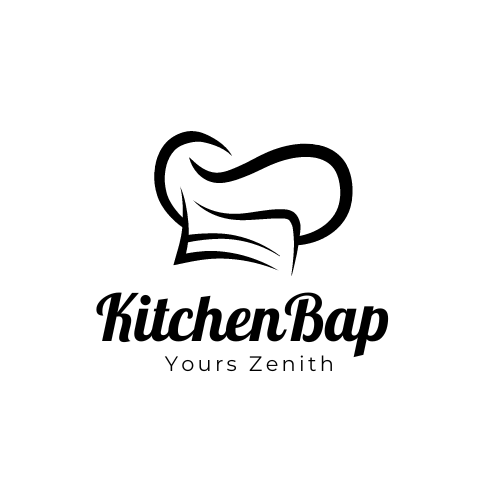

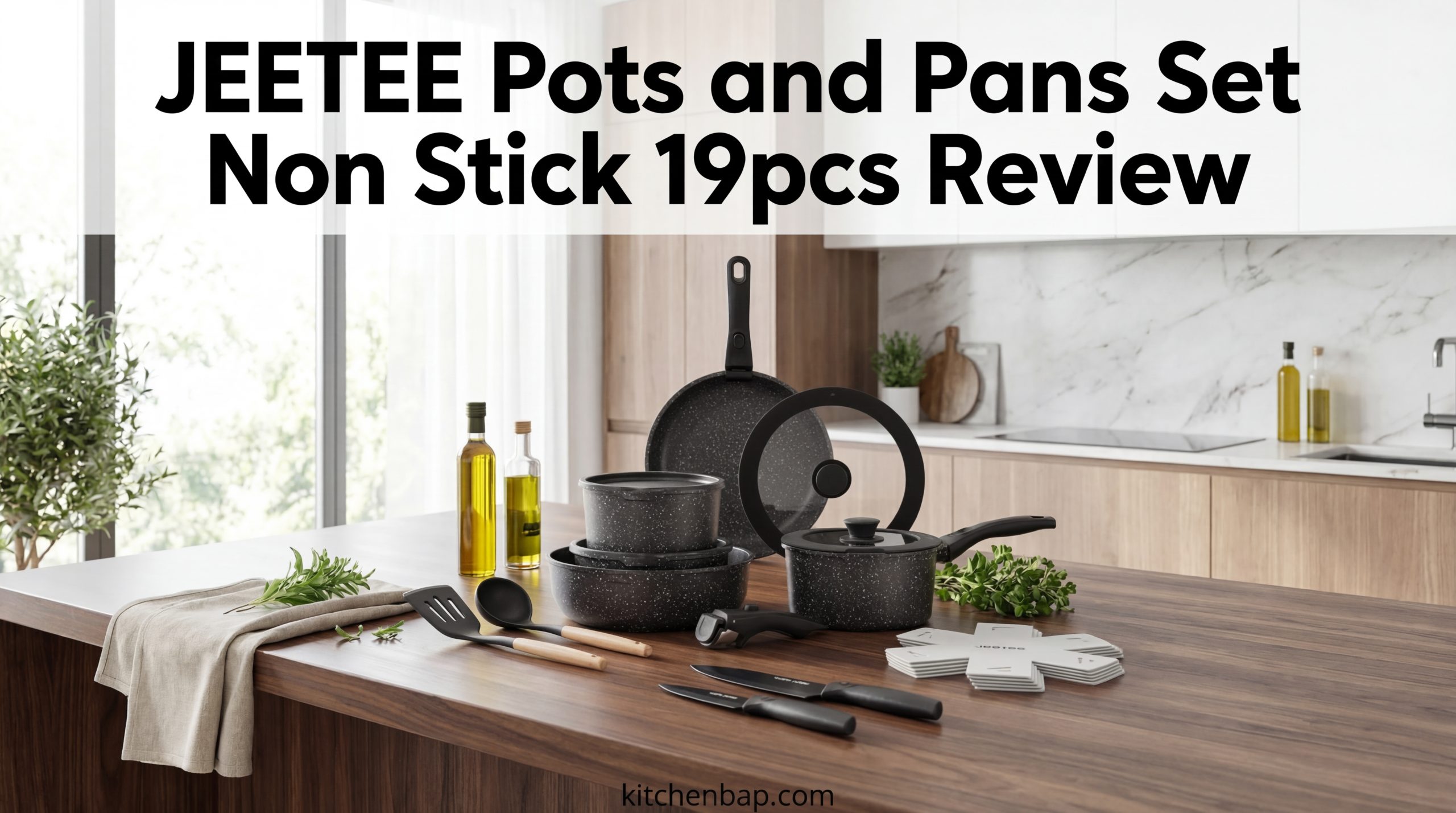


Leave a Reply